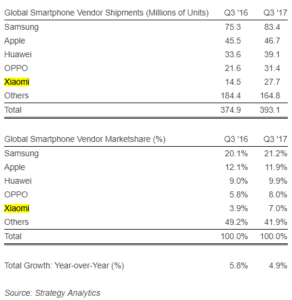From Zero to Hero – Xiaomi’s Short Journey into Becoming One of the Biggest Tech Giants in the World

How did Xiaomi, a 7-yr-old company, become one of the biggest technology firms in the world?
It took only 7 years for Xiaomi to go from a startup phone manufacturer to one of the biggest technology giants in China. The Company was founded in 2010 by Lei Jun, who believed that high quality technology products should be accessible to everyone.[1] Guided by that belief, the Company defied the common perception that low price is equal to low quality by introducing a line of affordable smartphones equipped with premium hardware, high build quality and specs that were comparable to Apple’s and Samsung’s but at a fraction of the price. Xiaomi has now entered the ranks of the top five smartphone brands in the world (Table 1) [2] and has recently gained the number two spot in India’s smartphone market share. Aside from its dominance in Asia’s smartphone business, Xiaomi has also expanded its tech product lines into over 80 offerings, ranging from wearable technology to smart home systems. Finally, Xiaomi over the years has also amassed a loyal fan base (“Mi-Fans”), who travel miles across China to attend the Company’s new product launches[3]. A large part of Xiaomi’s rapid growth and success can be attributed to the Company’s digital strategy and implementation – as seen through its business operations, marketing, and investment decisions.
Table 1: Smartphone Market Share

Direct to Consumer Platform
While Xiaomi has only recently started to expand its brick and mortar retail stores, the Firm’s core distribution strategy is centered around its direct to consumer (DTC) model. While companies like Apple need to go through the process of sourcing, manufacturing, warehousing and finally distribution, Xiaomi sells majority of its products through its e-commerce platform. This strategy not only reduces real estate costs, but also more quickly delivers the products with the latest technology to its customers. To keep its inventory cost down, Xiaomi deploys a flash sale strategy whereby only a limited quantity of phones is sold online each week, further increasing the demand and awareness for the products[4].
Earned Media
In addition to the natural scarcity value and hype that are created by its periodic flash sales, Xiaomi uses social media as its main source of promotion to increase customer awareness and engagement. Rather than spending billions of dollars on traditional forms of advertising, Xiaomi is extremely active on social media and often posts daily communications around product launches, promotions, industry trends, and even contests that help generate more user interaction. Through their own managed community forums, Xiaomi’s most loyal fans, the “Mi-fans” often meet online to discuss Xiaomi’s latest products and even chat with the Company’s engineers to share product feedback. Its loyalty program[5] allows users to earn points with each new purchase, which grants users product discounts and a chance to become beta testers. Xiaomi’s digitally-focused, earned-media strategy therefore not only keeps its advertising costs down but also creates a sense of authenticity and high levels of user engagement.
Suite of Connected Products
In 2013, Xiaomi’s business strategy moved beyond smartphones as the Company made big bets on the Internet of Things (IoT). Instead of building connected products in-house, Xiaomi decided to invest in tech companies that each focus on making different types IoT products, which are then integrated into Xiaomi’s ecosystem and connected through Xiaomi’s Mi Home app (Table 2). With around 10-20% ownership in each of the companies, Xiaomi is granted the right to brand and sell these different products, and in exchange, Xiaomi allows these companies access to its sales team, designers, and supplier network[6]. In addition, the Company has a dedicated platform for its IoT products that has attracted over 400 hardware partners, making it one of the largest IoT hardware platforms in the world[7].
Xiaomi’s DTC strategy, strong social media presence and its long-term investment in IoT are major contributors to its rapid growth over the past 7 years. The Company is seeking an IPO at a valuation of ~$50 billion, which would be one of the biggest tech IPOs in history. And with a foothold already established in India, the IPO would help further the Company’s ambition in expanding its tech empire.
Table 2.: Selected Xiaomi Products

End Notes
[1] Xiaomi Company Website. https://www.mi.com/in/about/
[2] Business Wire. “Strategy Analytics: Xiaomi Soars as Global Smartphone Shipments Hit 393 Million in Q3 2017.” November 2, 2017. https://www.businesswire.com/news/home/20171102006900/en/Strategy-Analytics-Xiaomi-Soars-Global-Smartphone-Shipments
[3] Business Insider. “The West Has No Idea How Fanatical Xiaomi’s Fans Are”. January 9, 2015. http://www.businessinsider.com/xiaomis-secret-weapon-its-fans-2015-1
[4] PC World. “Why are Xiaomi Phones so Cheap?”. May 16, 2014. https://www.pcworld.com/article/2156320/why-are-xiaomi-phones-so-cheap.html
[5] Tech in Asia. “These 10 Ingredients are the Recipe to Xiaomi’s Secret Sauce.” November 14, 2014. https://www.techinasia.com/10-strategies-xiaomi-secret-sauce
[6] WIRED. “China’s Plan to Rule the World.”. https://www.wired.com/2017/01/china-consumer-electronics/
[7] The Motley Fool. “Will Xiaomi Launch the Biggest Tech IPO of 2018?.” December 18, 2017. https://www.fool.com/investing/2017/12/18/will-xiaomi-launch-the-biggest-tech-ipo-of-2018.aspx



Xiaomi’s rise is remarkable. It seems like Xiaomi has been able to carve out a space for itself through great branding and marketing, not necessarily a very differentiated product. An advantage they had was entering the market later and being able to integrate e-commerce and social media into their strategies from the outset. I wonder if incumbents can learn anything from Xiaomi, and whether it’s too late for them to leverage earned media in the same way. Similarly, I imagine it’s too difficult for the incumbents to extract themselves from the relationships that they have built up over the years. It will be very interesting to follow Xiaomi’s trajectory from here.